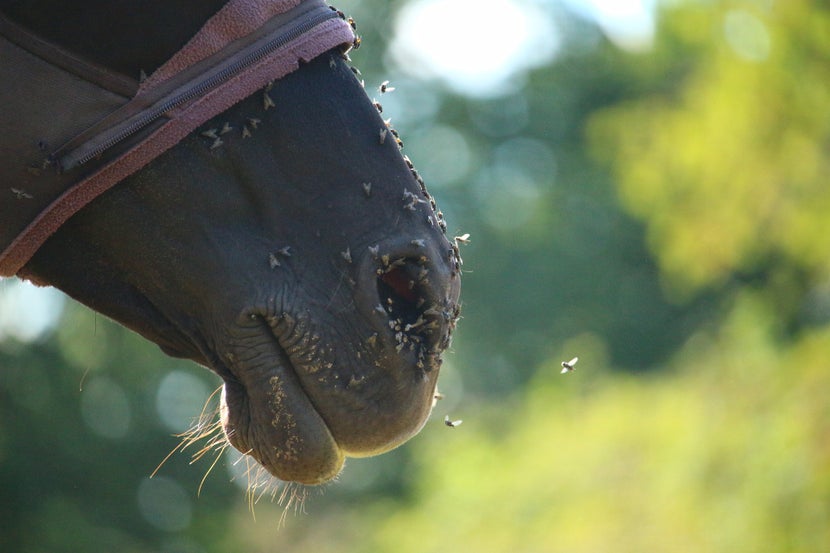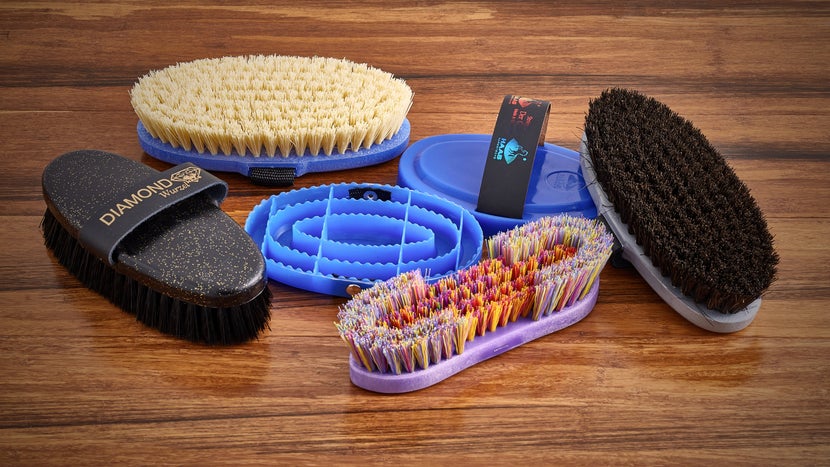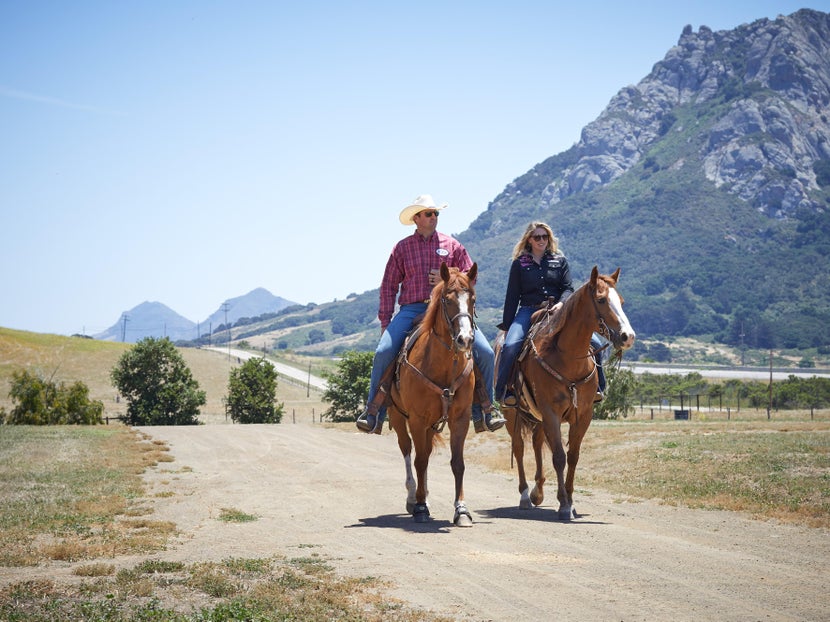Beat the Heat: An Expert Guide
on Horse Care for the Summer
Summer is just around the corner! For many of us, this means more sunshine, warmer days, and more time with our equine companions. While we equestrians can usually take a break and cool down in the luxury of air conditioning, our horses cannot. We therefore are responsible for keeping our horses healthy and comfortable throughout the hotter months.
Horses are sensitive to heat; any extreme summertime weather and sunlight can be dangerous for most horses, especially ones not acclimated to the intense temperatures. Toward the end of this article, we will address heat stress signs in horses that all equestrians should be aware of, in the possible event that your horse starts exhibiting these symptoms. Continue reading for some simple, practical tips to keep you and your equine companions cool!
Horse Hydration During the Summer

For maintenance, the average horse needs at least 5 gallons of fresh water every day. This can easily double or even triple when they're working in hot weather, so make sure your horse is well-hydrated throughout the summer months. Keep several water sources available if possible, and refill the buckets or troughs with fresh water at least daily.
Large containers of stagnant water, such as troughs or large buckets, encourage the growth of algae, bacteria, and slime (especially in warm weather). We don't want to drink dirty water, and neither do our horses! Clean any troughs and buckets often to offer your horse access to fresh, clean water. If possible, keep water sources shaded or use insulated pipes. Cool water will encourage your horse's water consumption. Consider installing an automatic waterer where possible.
On particularly hot days, your horse may need a drink mid-ride. Have a bucket of water ready by the ring, or trail ride at locations you know offer a water source. We focus so much of our energy on our horses, but we cannot forget about our own human hydration needs! Keep cool water handy while in the saddle with a water bottle holder, and take drinks throughout the day with your water bottle of choice.
| Shop Horse Watering Systems |
Why Electrolytes are Essential in Heat

When horses sweat more, as they will inevitably do in hot weather to help themselves cool down, they need more minerals like salt to maintain their biochemistry. For maintenance purposes, add an ounce (2 tablespoons) of salt supplement to your horse's daily diet in warm weather; consider doubling that amount in hot, humid conditions. You can also offer a salt lick or block in your horse's stall or paddock.
In hot weather or after heavy exercise, your horse may require supplemental electrolytes to replace minerals lost through sweat—particularly sodium, chloride, potassium, and magnesium. Electrolytes encourage your horse to drink as well, and some can even be mixed with water for improved flavor! Provide access to fresh water after your horse has been given electrolytes with their feed, since the salt contained in electrolytes will make them thirsty. If you're mixing their electrolytes in water, an additional fresh water source should also be provided. For more information, read our equine electrolyte guide!
| Shop All Electrolyte Horse Supplements |
Fly Protection Methods for Summer

Depending on your environment and where your horse is kept, summer heat may mean pests like mosquitos and flies. Since mosquitos lay their eggs in standing water, you can reduce their reproduction by eliminating stagnant water around the barn or paddocks. If sitting water can't be eliminated (think troughs or buckets), you can add a little apple cider vinegar to help keep mosquitos away. To prevent the flies from bothering your horse, maintain a clean stall, and consider using physical barriers like a fly mask or fly sheet. For additional protection before riding, apply fly spray to keep your horse focused on you and not the bugs. For more tips, check out our guide to fly control for the barn, stable, and pasture.
Not sure where to get started? Check out the best fly masks, fly sheets, and fly sprays of the year!
| Shop All Fly Control |
Summer Coat Maintenance & Grooming

Some horses may start growing their winter coats early or hang on to them late, making them furry when it's quite warm out. Other horses might have conditions like Cushing's disease that result in especially heavy coats. Regardless of the cause, keep your horse clipped if their coat is out of step with the weather. Regular grooming and bathing during the summertime will help maintain a lighter, healthier coat as well. Check out our page link below for grooming products and tools.
If you are considering clipping your horse, check out our how-to body clip article!
| Shop Horse Grooming Supplies |
Adjust Turnout & Offer Shade to Accommodate the Heat

Develop a turnout schedule for each horse, taking into account any specific health issues or challenges. Generally, your turnouts need to move to late night or early morning hours when the temperatures are coolest. Depending on your location, the hottest part of the day is usually between 2:00 and 4:00 in the afternoon. Check your local weather and plan to bring in horses well before the peak of the heat each day!
Providing your horse with opportunities to escape from the sun's rays can significantly benefit their well-being over the summer. Whether it's a man-made shelter or a copse of trees, shady spots can be up to 10 degrees cooler than areas in direct sunlight. If shaded turnout isn't an option, adjust your turnout schedule accordingly.
Finally, horses with pink skin or light coats are prone to sunburn. Apply generous amounts of sunscreen to those pink noses, white socks, and other areas! We suggest either the Healthy HairCare Sunflower Suncoat SPF Horse Sunscreen or Absorbine Santa Fe Coat Conditioner & Sunscreen Spray.
Adjust Ride Time for Heat

Shift your ride time to the cooler parts of the day, generally early morning. Things start to warm up soon after the sun rises, so it's best to get your ride in as early as possible! Check your local weather for the time of sunrise and attempt to finish your ride before or around that time. If you cannot change your ride time, lighten the load by reducing the work intensity or ride duration.
Some days simply may be too hot to do significant ride work; if so, opt for a casual walk on a loose rein and provide your horse a cooling rinse or bath afterward. Working your horse in high heat can be dangerous, as they dehydrate easily—some may even collapse. Be vigilant in keeping a close eye on your horse!
Tack & Cooling Your Horse Down in the Heat

As horses sweat more while exercising during the summer, you should opt for more breathable saddle pad materials to prevent your equine from overheating. Similarly, any leg protection needs to be breathable and moisture-wicking.
To cool your horse down after you've finished working them, here are a few suggestions:
- Remove all tack
- Sponge or hose your horse to wash away sweat and dirt
- Use a sweat scraper to remove excess water (water left on your horse can act as a blanket, retaining heat and interfering with their cooling process)
- If the horse is panting or blowing hard, repeat the process
- Monitor water intake, offering cool water in small amounts (too much cold water at once can lead to colic)
Consider finishing up with a cooling liniment, such as the Absorbine CoolDown Herbal Rinse After Workout Liniment, for additional benefits. For easy application, mix the liniment with water in a spray bottle. You can also supplement the above list by toweling your horse off or turning a fan on them instead. A stall-mounted fan can make a big difference; it keeps the air moving, and your horse will be much happier as a result! Your horse will cool as any water or sweat on them evaporates.
Cooling Treats for Cooling Comfort

You can easily give your horse some cooling stimulation by placing cut-up fruits or veggies in water overnight in the freezer—voila, horse-friendly popsicles! For something special, just drop the frozen treat block in your horse's feed bucket. It will keep your horse cool and occupied on a long, hot day!
| Shop Horse Toys & Treats |
Special Health Considerations

Heat Stroke and Heat Stress Signs in Horses
Heat stroke and heat stress can be very detrimental to horses. Symptoms to watch out for include:
- Elevated breathing rate (normal rate for adult horses at rest: 10 to 24 breaths per minute)
- Elevated pulse/heart rate (normal: 28 to 44 beats per minute)
- Irregular heartbeat
- Profuse sweating or no sweat at all
- High body temperature (normal: 37.2° to 38.3° C.)
- Depression or lethargy
- Signs of dehydration (dry mucus membranes, a caved-in look, or skin that doesn't bounce back when pinched)
If you suspect heat stroke, call your vet. While waiting for the vet to arrive, keep your horse in the coolest, shadiest place available. If you have water you can stand them in, such as a pond, pool, or lake, do so. Keep sponging your horse down with cool water, and keep a fan on them if possible.
Anhidrosis
Anhidrosis is a condition where the horse is unable to sweat or has difficulty doing so. Such horses may especially struggle during the hot summer months. General management options for non-sweaters are similar to the steps taken with all horses, such as providing shade and turning out at night, putting fans in stalls, misting or hosing down the horse regularly, and full-body clipping to help regulate the core body temperature.
Some horses respond very well to simple electrolyte supplementation to promote thermoregulation. For horses that may need additional support, an anhidrosis-specific supplement may be effective to encourage normal sweating.
Bonus: Protect Yourself from the Sun!

While it's important to pay extra attention to your horse during the summer, you can't ignore your own comfort and safety! The right clothes can help you beat the heat while you are out and about with your equine pal. UV-protective apparel is a great option for the hot summer months. Look for clothing with breathable materials and high UPF figures to keep you cool and protect your skin. To see our favorites, check out the best sun shirts, summer riding tights, and summer gloves. Or read our guide on the best sun protection gear for horseback riding!
If you opt to leave some skin exposed to the elements, make sure you apply and reapply sunscreen throughout the day, especially if you've been sweating.
Consider adding a sun visor or additional accessories to better block out the sun. To find the right one, check out our guide on how to pick a helmet visor!
| Shop All UV Protection Apparel & Accessories |
Closing Thoughts

Summer can be a great time to get out and enjoy the outdoors with your horse. But hot weather may require adjustments to your horse and riding management, like changes related to turnout and supplementation. With planning and preparation, as well as a few of the above tips and tricks, you will be able to enjoy summer while keeping both you and your horse happy, comfortable, and cool! If you have any additional questions, feel free to reach out to our friendly customer service team at 1-800-620-9145 or info@ridingwarehouse.com for further assistance.